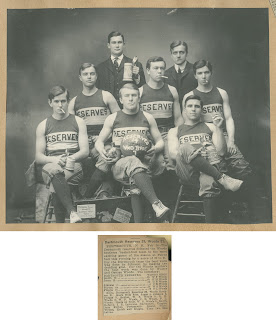 |
| Aegis, 1971 |
 |
| Aegis, 1971 |
Through the College Archives, you can piece together a rich history of many social organizations on campus. Perhaps you should resolve this year to visit Rauner and explore the history of a part of Dartmouth important to you.
 |
| Aegis, 1971 |
 |
| Aegis, 1971 |
 In his December 24, 1929, letter to Robert Frost, Joseph Blumenthal, head of the Spiral Press, writes that he and his wife feel privileged to have the pleasure of using Frost's poem "Christmas Trees" for their Christmas card that year.
In his December 24, 1929, letter to Robert Frost, Joseph Blumenthal, head of the Spiral Press, writes that he and his wife feel privileged to have the pleasure of using Frost's poem "Christmas Trees" for their Christmas card that year. Picture of a Witness Tree
As in my book about to be;
Which see
 |
| 1951 Christmas card inscription to Mrs. Eberhart, wife of poet Richard Eberhart |
 |
| 1942 card, with a hand-colored illustration by J. O’Hara Cosgrave |
 Robert Mudie, born in Scotland in 1777, was a teacher, author, editor and illustrator, who wrote or compiled nearly 90 volumes in his lifetime. Among them is Winter…one of his 4-volume series on the seasons.
Robert Mudie, born in Scotland in 1777, was a teacher, author, editor and illustrator, who wrote or compiled nearly 90 volumes in his lifetime. Among them is Winter…one of his 4-volume series on the seasons. Nobody would accuse Bartok of being "pop," and his Bluebeard's Castle is a notoriously difficult opera. Filled with abstract language and minimal movement, the one-act opera challenged performers and their audiences. But, in 1972, book artist Ronald King produced a dark pop-up version that takes Bartok's work to a new level of abstraction.
Nobody would accuse Bartok of being "pop," and his Bluebeard's Castle is a notoriously difficult opera. Filled with abstract language and minimal movement, the one-act opera challenged performers and their audiences. But, in 1972, book artist Ronald King produced a dark pop-up version that takes Bartok's work to a new level of abstraction. In 1754, Eleazar Wheelock established a school for tutoring and training Indians in Lebanon Connecticut. Wheelock’s school began modestly, but he soon realized that if it were to grow he would need to incorporate it, both so he could maintain control of the school, but also so that the school itself could hold real property. This was the beginning of what would prove to be a long process to acquire a charter.
In 1754, Eleazar Wheelock established a school for tutoring and training Indians in Lebanon Connecticut. Wheelock’s school began modestly, but he soon realized that if it were to grow he would need to incorporate it, both so he could maintain control of the school, but also so that the school itself could hold real property. This was the beginning of what would prove to be a long process to acquire a charter. The fascination with finding natural wonders in the New World lingered long after the initial rush of first encounters, and exotic "discoveries" continued to catch the public's attention. The cover of this 1768 Bickerstaff's Boston Almanack (London, 1768), depicts the "Giants lately discovered in South America." The figure of the European sailor is said to be 5 foot 11 and 1/2 inches, and is offering the South American giants a biscuit.
The fascination with finding natural wonders in the New World lingered long after the initial rush of first encounters, and exotic "discoveries" continued to catch the public's attention. The cover of this 1768 Bickerstaff's Boston Almanack (London, 1768), depicts the "Giants lately discovered in South America." The figure of the European sailor is said to be 5 foot 11 and 1/2 inches, and is offering the South American giants a biscuit.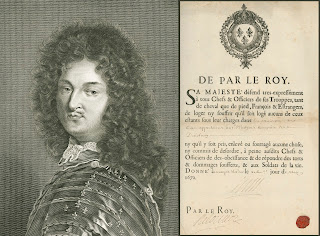 You may have a signed photo from your favorite celebrity, but can you match a collection of autographs from notable French rulers and other "illustrious personages?" Starting with a Francis I document from 1529 and ending with a nineteenth-century letter from Napoleon III, this collection includes signatures from Catherine de Medici, Cardinals Richelieu and Mazarin, the "sun king" Louis XIV, Marie Antionette, and Napoleon Bonaparte among others.
You may have a signed photo from your favorite celebrity, but can you match a collection of autographs from notable French rulers and other "illustrious personages?" Starting with a Francis I document from 1529 and ending with a nineteenth-century letter from Napoleon III, this collection includes signatures from Catherine de Medici, Cardinals Richelieu and Mazarin, the "sun king" Louis XIV, Marie Antionette, and Napoleon Bonaparte among others. When Charles Wilkes' U.S. Exploring Expedition returned from its search for the Antarctic continent in 1842, it inspired the creation of an 11,000 square foot panoramic mural that toured the country. This manuscript was the script for seaman Charles Erskine's lecture given while the panorama was scrolled in front of an audience at the Roxbury Mechanic's Institute in Roxbury, Massachusetts. It attests to the public appetite for exploration stories and the 19th-century love of panoramas as popular entertainment.
When Charles Wilkes' U.S. Exploring Expedition returned from its search for the Antarctic continent in 1842, it inspired the creation of an 11,000 square foot panoramic mural that toured the country. This manuscript was the script for seaman Charles Erskine's lecture given while the panorama was scrolled in front of an audience at the Roxbury Mechanic's Institute in Roxbury, Massachusetts. It attests to the public appetite for exploration stories and the 19th-century love of panoramas as popular entertainment. Dartmouth has its share of quirky traditions. One of the oddest involved a giant wooden spoon. Each fall, usually in October or November, the Junior Class would assemble and a series of "honors" would be bestowed on class members. Among the awards was a giant wooden spoon given annually to the "heaviest eater of the Junior Class." The tradition appears to have started sometime before 1871 and continued up to 1906.
Dartmouth has its share of quirky traditions. One of the oddest involved a giant wooden spoon. Each fall, usually in October or November, the Junior Class would assemble and a series of "honors" would be bestowed on class members. Among the awards was a giant wooden spoon given annually to the "heaviest eater of the Junior Class." The tradition appears to have started sometime before 1871 and continued up to 1906. 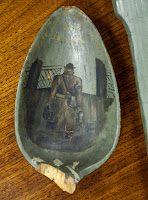 We have two of the spoons in our collections. One has been painted and shows a student departing from the college with suitcases in hand, above reads, "Thru Dartmouth's Classic Hall I Strayed." The other was presented to Randolph McNutt, Class of 1871. McNutt appeared to have stayed fit despite his hearty appetite, but he did become a fat cat in the business world, amassing a fortune as a distributor of school furnishings and through real estate dealings. He bequeathed $500,000 to Dartmouth in 1927, and two years later, Tuck Hall was renovated and renamed McNutt Hall in his honor.
We have two of the spoons in our collections. One has been painted and shows a student departing from the college with suitcases in hand, above reads, "Thru Dartmouth's Classic Hall I Strayed." The other was presented to Randolph McNutt, Class of 1871. McNutt appeared to have stayed fit despite his hearty appetite, but he did become a fat cat in the business world, amassing a fortune as a distributor of school furnishings and through real estate dealings. He bequeathed $500,000 to Dartmouth in 1927, and two years later, Tuck Hall was renovated and renamed McNutt Hall in his honor. Charles V, Holy Roman Emperor, King of Spain, ruler of half of Europe and a goodly portion of the New World, may not have respected Cartman's "authoritah" but he would have agreed with the sentiment. This grant of arms to Nicholas de Almacan of Arequipa, Peru, from May 14, 1552, features Charles V in the center of the illuminated border. Facing the reader, he is flanked by an image of Caesar on the right and the conquistador Pizarro on the left, both ceding their authority to him though their gaze. The highly decorated initial letter adds another lay of authority to the document: it contains the crest of the arms of the House of Habsburg.
Charles V, Holy Roman Emperor, King of Spain, ruler of half of Europe and a goodly portion of the New World, may not have respected Cartman's "authoritah" but he would have agreed with the sentiment. This grant of arms to Nicholas de Almacan of Arequipa, Peru, from May 14, 1552, features Charles V in the center of the illuminated border. Facing the reader, he is flanked by an image of Caesar on the right and the conquistador Pizarro on the left, both ceding their authority to him though their gaze. The highly decorated initial letter adds another lay of authority to the document: it contains the crest of the arms of the House of Habsburg. The theme of the performance is based on Andreas Vesalius's De humani corporis fabrica (On the structure of the human body) anatomical illustrations of the dissected body circa 1543. This extraordinary book is in the Rauner Special Collections and was displayed in the atrium gallery area of Baker Library last year. The anatomical drawings have inspired the group choreography conceived by ensemble member Mayuka Kowaguchi '11.
The theme of the performance is based on Andreas Vesalius's De humani corporis fabrica (On the structure of the human body) anatomical illustrations of the dissected body circa 1543. This extraordinary book is in the Rauner Special Collections and was displayed in the atrium gallery area of Baker Library last year. The anatomical drawings have inspired the group choreography conceived by ensemble member Mayuka Kowaguchi '11.  We have plenty of contemporary artists' books in Rauner that make inventive use of ordinary objects, but it's much rarer to find an older book bound with materials as strange as packing crates and harness leather. Aurora Australis, an anthology of poems, essays, and illustrations about life in Antarctica, has an excellent reason for its odd binding -- it was printed by the members of Ernest Shackleton's 1907-1909 Nimrod Expedition in the middle of an Antarctic winter.
We have plenty of contemporary artists' books in Rauner that make inventive use of ordinary objects, but it's much rarer to find an older book bound with materials as strange as packing crates and harness leather. Aurora Australis, an anthology of poems, essays, and illustrations about life in Antarctica, has an excellent reason for its odd binding -- it was printed by the members of Ernest Shackleton's 1907-1909 Nimrod Expedition in the middle of an Antarctic winter.Dust from the stove fills the air and settles on the paper as it is being printed.... It is too cold to keep the printer's ink fluid; it gets sticky and freezes... the printers were called away while the candle was burning, and... when they returned they found that the plate had overheated and melted the inking roller of gelitinous substance. I believe it was the only one on the Continent and had to be re-cast somehow.In all, about 90 copies of Aurora Australis were printed, bound, and distributed to the members of Shackleton's expedition. Rauner's is affectionately known as the "Oatmeal Copy" for the label which is partially visible on the inside board cover.
 Had you been a College freshman 99 years ago, you would at this moment be purchasing your freshman cap, a newly instituted requirement intended to make it easier to identify members of the entering class.
Had you been a College freshman 99 years ago, you would at this moment be purchasing your freshman cap, a newly instituted requirement intended to make it easier to identify members of the entering class. Freshman caps will henceforth add a touch of the picturesque and a deeper hue to Dartmouth's campus. The custom just initiated is worthy of continuing down the long years of the history of the College until it becomes a tradition as fixed and revered as the traditions that cluster about the old pine or the senior fence.
It is curious how few years are required to establish a new custom and to give it all the authority of a habit handed down from antiquity. Four years hence, when all the classes now present in College have graduated, the freshman cap will have become a permanent feature of Dartmouth undergraduate life, and the ordinary student will associate its origin with the Indians, Eleazar Wheelock, the "Dartmouth Song," and the founding of the College.

 This original 1896 edition of Pictures of People by Charles Dana Gibson is currently on display in the Hood Museum's Space for Dialogue, in an exhibition curated by Sarah Peterson '10. Sarah describes the compilation of Gibson's early pen and ink drawings as follows:
This original 1896 edition of Pictures of People by Charles Dana Gibson is currently on display in the Hood Museum's Space for Dialogue, in an exhibition curated by Sarah Peterson '10. Sarah describes the compilation of Gibson's early pen and ink drawings as follows: Sir Arthur Conan Doyle, creator of Sherlock Holmes, lost his son Kingsley during the 1918 influenza pandemic, two weeks before the Armistice that ended the First World War. Over the course of the war, Conan Doyle’s brother, two brothers-in-law, and nephew also died. In the wake of these losses, he became devoted to promoting spiritualism, which may have provided consolation in his grief, as it did to many who sought contact with departed loved ones. Many of Conan Doyle’s spiritualist writings omitted identifying him as the creator of Sherlock Holmes.
Sir Arthur Conan Doyle, creator of Sherlock Holmes, lost his son Kingsley during the 1918 influenza pandemic, two weeks before the Armistice that ended the First World War. Over the course of the war, Conan Doyle’s brother, two brothers-in-law, and nephew also died. In the wake of these losses, he became devoted to promoting spiritualism, which may have provided consolation in his grief, as it did to many who sought contact with departed loved ones. Many of Conan Doyle’s spiritualist writings omitted identifying him as the creator of Sherlock Holmes. The famous last word and repeating refrain from Edgar Allan Poe's classic poem The Raven is arguably a one word summary of the entire work. First published in 1845, the poem follows an anonymous narrator as he mourns the "lost Lenore" and attempts to divine his own fate by questioning a mysterious raven whose only response is "Nevermore." The supernatural atmosphere and imagery evoked by the story and language of the poem have inspired many artists, including John Tenniel of Alice in Wonderland fame and Édouard Manet.
The famous last word and repeating refrain from Edgar Allan Poe's classic poem The Raven is arguably a one word summary of the entire work. First published in 1845, the poem follows an anonymous narrator as he mourns the "lost Lenore" and attempts to divine his own fate by questioning a mysterious raven whose only response is "Nevermore." The supernatural atmosphere and imagery evoked by the story and language of the poem have inspired many artists, including John Tenniel of Alice in Wonderland fame and Édouard Manet.  |
| "Doubting, dreaming dreams no mortal ever dared to dream before." |
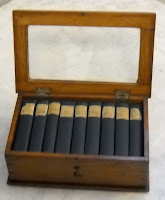 It is hard to know where to start with this object. It is a set of Shakespeare's plays, in nine miniature volumes. The full text is there, printed by William Pickering in 1825. It is a case where a beloved text was produced to serve as a kind of fetish object--too small to be read comfortably, the set represents the larger whole, the whole of Shakespeare.
It is hard to know where to start with this object. It is a set of Shakespeare's plays, in nine miniature volumes. The full text is there, printed by William Pickering in 1825. It is a case where a beloved text was produced to serve as a kind of fetish object--too small to be read comfortably, the set represents the larger whole, the whole of Shakespeare. |
| Dorthy Meets the Scarecrow |
 One of the critical events that led up to the infamous Zoot Suit Riots in L.A. was the Sleepy Lagoon murder case. In 1942, a group of young Latino men were charged with the murder of Jose Diaz. 17 were convicted of first degree murder. The case brought to light the deep racial tensions that flared up two years later with rioting in Los Angeles and other cities across the country.
One of the critical events that led up to the infamous Zoot Suit Riots in L.A. was the Sleepy Lagoon murder case. In 1942, a group of young Latino men were charged with the murder of Jose Diaz. 17 were convicted of first degree murder. The case brought to light the deep racial tensions that flared up two years later with rioting in Los Angeles and other cities across the country.We are at war. We are at war not only with the armies of the Axis powers, but with the poison-gas of their doctrine, with the "biological basis" of Hitler and with his theories of race supremacy....
We are at war with the premise on which seventeen boys were tried and convicted in Los Angeles, sentenced to long prison terms on January 13th of this year. We are at war with the Nazi logic so clearly and unmistakably set fourth by Mr. Ed. Duran Ayres, the logic which guided the judge and jury and dictated the verdict and the sentence.
And because this global war is everywhere a people's war, all of us are in it together, all of us together take up the challenge of Sleepy Lagoon.
 This time it's not about the content, it's all about the presentation. Bound by Sangorski and Sutcliffe, this bookbinding masterpiece is one of a number the pair produced in the early-twentieth century. Like many similar examples, Rauner's copy was designed for the Rubáiyát of Omar Khayyám. However, as the cliché states, you can't judge a book by its cover, and the sumptuous exterior stands in contrast to the fairly standard text block, which is from the 3rd edition (London: Bernard Quaritch, 1872).
This time it's not about the content, it's all about the presentation. Bound by Sangorski and Sutcliffe, this bookbinding masterpiece is one of a number the pair produced in the early-twentieth century. Like many similar examples, Rauner's copy was designed for the Rubáiyát of Omar Khayyám. However, as the cliché states, you can't judge a book by its cover, and the sumptuous exterior stands in contrast to the fairly standard text block, which is from the 3rd edition (London: Bernard Quaritch, 1872).  The most famous of these Rubáiyát bindings was lost on the Titanic and has been dubbed the "Great Omar." Though not nearly as complex a binding as the "Great Omar" which featured several thousand individual jewels and leather onlays, our copy does include precious and semi-precious materials and a similar peacock motif on the front cover. The serpent twined around the gold-leaf chalice on the back cover is made from real snake skin, naturally.
The most famous of these Rubáiyát bindings was lost on the Titanic and has been dubbed the "Great Omar." Though not nearly as complex a binding as the "Great Omar" which featured several thousand individual jewels and leather onlays, our copy does include precious and semi-precious materials and a similar peacock motif on the front cover. The serpent twined around the gold-leaf chalice on the back cover is made from real snake skin, naturally. At first glance, Sherman Denton's As Nature Shows Them: Moths and Butterflies of the United States (Boston, J. B. Millett, 1908) appears to be just another field guide for butterfly enthusiasts. But a closer look shows something extraordinary: the illustrations seem to shimmer like the flash of a butterfly wing in the sun. That is because the color plates are, in the words of the maniacally obsessed author:
At first glance, Sherman Denton's As Nature Shows Them: Moths and Butterflies of the United States (Boston, J. B. Millett, 1908) appears to be just another field guide for butterfly enthusiasts. But a closer look shows something extraordinary: the illustrations seem to shimmer like the flash of a butterfly wing in the sun. That is because the color plates are, in the words of the maniacally obsessed author:Direct transfers from the insects themselves; that is to say, the scales of the wings of the insects are transferred to the paper while the bodies are printed from engravings and afterward colored by hand. The making of such transfers is not original with me, but it took a good deal of experimenting to so perfect the process as to make the transfers, on account of their fidelity to detail and their durability, fit for use as illustrations in such a work. And what magnificent illustrations they are, embodying all the beauty and perfection of the specimens themselves!
As I have had to make over fifty thousand of these transfers for the entire edition, not being able to get any one to help me who would do the work as I desired it done, and as more than half the specimens from which they were made were collected by myself, I having made many trips to different parts of the country for their capture, some idea of the labor in connection with preparing the material for the publication may be obtained.
 So goes the often misquoted announcement by Jack Swigert after one of the spacecraft's oxygen tanks ruptured during the Apollo 13 mission. The ultimate cause of the rupture was determined to be a fairly lengthy chain of unlikely events. This is detailed in the NASA report from July 1970, titled Apollo 13 Cryogenic Oxygen Tank 2 Anomaly: Anomaly Report No. 1. Shown here is an onboard camera image of the tank area after the rupture. This report as well as the mission plan and final report for Apollo 13 can be found in the papers of Richard Allenby, Dartmouth class of 1944.
So goes the often misquoted announcement by Jack Swigert after one of the spacecraft's oxygen tanks ruptured during the Apollo 13 mission. The ultimate cause of the rupture was determined to be a fairly lengthy chain of unlikely events. This is detailed in the NASA report from July 1970, titled Apollo 13 Cryogenic Oxygen Tank 2 Anomaly: Anomaly Report No. 1. Shown here is an onboard camera image of the tank area after the rupture. This report as well as the mission plan and final report for Apollo 13 can be found in the papers of Richard Allenby, Dartmouth class of 1944.  People always ask us what is the most requested item in our collections. When we answer, they are almost always surprised. That is because the most requested item in our collections is something that is hardly ever requested by Dartmouth students, faculty, or staff--90% of its use is from visitors. What is it? The first edition of Joseph Smith's The Book of Mormon; An Account Written by the Hand of Mormon upon Plates Taken from the Plates of Nephi (Palmyra, NY: Printed by E.B. Grandin for the author, 1830).
People always ask us what is the most requested item in our collections. When we answer, they are almost always surprised. That is because the most requested item in our collections is something that is hardly ever requested by Dartmouth students, faculty, or staff--90% of its use is from visitors. What is it? The first edition of Joseph Smith's The Book of Mormon; An Account Written by the Hand of Mormon upon Plates Taken from the Plates of Nephi (Palmyra, NY: Printed by E.B. Grandin for the author, 1830).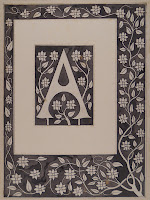 Though Aubrey Beardsley is perhaps best known for his more grotesque and erotic works, many of which were featured in illustrated editions of Oscar Wilde's writings, he was also involved in numerous other influential projects. One of these was the lavishly produced edition of Morte d'Arthur (London: J.M. Dent, 1893-1894) which was issued in 12 parts and included more than a thousand illustrations by Beardsley. The text was a reprint of the original William Caxton printing from 1485 with text by Sir Thomas Malory, but the spelling in this edition was updated to a more modern style - presumably to allow for easier reading.
Though Aubrey Beardsley is perhaps best known for his more grotesque and erotic works, many of which were featured in illustrated editions of Oscar Wilde's writings, he was also involved in numerous other influential projects. One of these was the lavishly produced edition of Morte d'Arthur (London: J.M. Dent, 1893-1894) which was issued in 12 parts and included more than a thousand illustrations by Beardsley. The text was a reprint of the original William Caxton printing from 1485 with text by Sir Thomas Malory, but the spelling in this edition was updated to a more modern style - presumably to allow for easier reading.  Shown here are both an original drawing and the final printed version of the illustrated chapter initial from book 13, chapter 1, which begins the story of the Grail and starts "At the vigil of Pentecost..." Though the original is unsigned, there is a note on the reverse which reads: "In my opinion this is a genuine drawing by Beardsley.--R.A. Walker (authority on Beardsley)"
Shown here are both an original drawing and the final printed version of the illustrated chapter initial from book 13, chapter 1, which begins the story of the Grail and starts "At the vigil of Pentecost..." Though the original is unsigned, there is a note on the reverse which reads: "In my opinion this is a genuine drawing by Beardsley.--R.A. Walker (authority on Beardsley)" Soon after Ted Geisel (Class of 1925), aka Dr. Seuss, graduated from Dartmouth, he worked in the advertising business. Among the more prominent clients he worked for was Standard Oil. He created ad campaigns for several of Standard Oil's products including an insecticide, "Flit," made primarily of mineral oil used to kill mosquitoes, flies, and other insects. Liberal spraying around the yard was encouraged. Dr. Seuss also created advertisements for Ex-Tane, a petroleum based cleaner, and and engine oil, "Essolube." Our collection contains advertisement work for all three products including this jigsaw puzzle, just recently acquired. It is part of "The Five Star Theater Foiled by Essolube: A Jig-Saw-Melodrama." It features a family driving away from a hoard of automotive monsters: the Zero-Doccus, the Karbo-Nockus, the Moto-Munchus, the Oilio-Gobelus, and the Moto-Raspus.
Soon after Ted Geisel (Class of 1925), aka Dr. Seuss, graduated from Dartmouth, he worked in the advertising business. Among the more prominent clients he worked for was Standard Oil. He created ad campaigns for several of Standard Oil's products including an insecticide, "Flit," made primarily of mineral oil used to kill mosquitoes, flies, and other insects. Liberal spraying around the yard was encouraged. Dr. Seuss also created advertisements for Ex-Tane, a petroleum based cleaner, and and engine oil, "Essolube." Our collection contains advertisement work for all three products including this jigsaw puzzle, just recently acquired. It is part of "The Five Star Theater Foiled by Essolube: A Jig-Saw-Melodrama." It features a family driving away from a hoard of automotive monsters: the Zero-Doccus, the Karbo-Nockus, the Moto-Munchus, the Oilio-Gobelus, and the Moto-Raspus.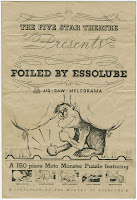 The advertisements show the evolution of Seuss's style, but they also force you to think about the evolution of his environmentalist ethic. In the late 1920s and 1930s, when these ads were created, petroleum products were hardly a concern to most Americans: they offered cheap fuel for progress. Only later, when the impact of pesticides, harsh chemical cleaners, and automobile exhaust became apparent, would these ads seem out of character. Seuss, of course, went on to create, The Lorax, a cautionary tale about the dangers of pollution brought on by mass consumerism and industry.
The advertisements show the evolution of Seuss's style, but they also force you to think about the evolution of his environmentalist ethic. In the late 1920s and 1930s, when these ads were created, petroleum products were hardly a concern to most Americans: they offered cheap fuel for progress. Only later, when the impact of pesticides, harsh chemical cleaners, and automobile exhaust became apparent, would these ads seem out of character. Seuss, of course, went on to create, The Lorax, a cautionary tale about the dangers of pollution brought on by mass consumerism and industry.
 What could be more appropriate for our 100th blog post than 100 Questions and Answers about Dartmouth College, published in 1937? Here, prospective students learned that Dartmouth teams "compete creditably" with other schools athletically, and that "Fraternity membership is not greatly emphasized at Dartmouth." Only 20% of the students received financial aid, but then tuition was a mere $450.
What could be more appropriate for our 100th blog post than 100 Questions and Answers about Dartmouth College, published in 1937? Here, prospective students learned that Dartmouth teams "compete creditably" with other schools athletically, and that "Fraternity membership is not greatly emphasized at Dartmouth." Only 20% of the students received financial aid, but then tuition was a mere $450. Dartmouth students used to be devoted scrapbookers. It seems hard to fathom now in the days of Facebook, but during freshman orientation new students would pick up blank scrapbooks with their names embossed in gold, nostalgically titled "Memorabilia from College Days." We have hundreds of these "Membooks" in our collection compiled by students from the mid-1800s up to around 1930, when they fell out of fashion. Membooks are our best window into student life from a century ago.
Dartmouth students used to be devoted scrapbookers. It seems hard to fathom now in the days of Facebook, but during freshman orientation new students would pick up blank scrapbooks with their names embossed in gold, nostalgically titled "Memorabilia from College Days." We have hundreds of these "Membooks" in our collection compiled by students from the mid-1800s up to around 1930, when they fell out of fashion. Membooks are our best window into student life from a century ago. 